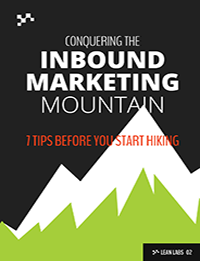Inbound marketing involves so many different components that it can be hard to keep track of everything you're doing and still maintain a perspective on your priorities. With a sound marketing strategy in place, it's far easier to remember your business objectives and how your various marketing operations are meant to bring you closer to these goals.
Which tactics and principles do you need to include in your inbound strategy? What's expendable and what's essential? In our experience, it all comes down to these six ingredients.
6 Characteristics of an Effective Inbound Strategy
1. A website designed with UX in mind
While beautiful graphic design is important, user experience (UX) is even more important. Visitors have to be able to figure out how to use a website or app quickly, so they can find the information, or perform the transaction, they came for. If they don’t enjoy their interaction with your site, they won’t stay for long and probably won't come back. New and small businesses will be making their first impressions with customers via their websites, so it’s doubly important to focus on UX.
UX is especially crucial for complex sites such as e-commerce shops. The site has to be well organized, with clear and easy-to-use navigation and secure payment options.
2. Clear copy and micro-copy
The content on your website is arguably as crucial as its design. Content should be clear and easy to read, properly spaced and not too long. Micro-copy, such as navigation links and button texts, should be written with extreme care. It should all be geared toward providing users with useful information that will solve their problems and help them succeed.
Passionate, upbeat copy will convince a potential customer to click on that "Buy Now" button. Bland copy makes it hard to differentiate yourself or to get audience members excited about what you have to offer.
3. Well-designed landing pages with compelling offers
One of the best ways to market to potential customers is through direct emails. In order to build your list of relevant email addresses, many businesses offer free products, such as ebooks, in exchange for visitors' email address.
This strategy can be extremely effective if taking advantage of the offer is easy and attractive. Users don’t want to fill out long forms, and many of them are likely to give up midway. And no one is going to give up any contact information if you haven't made a solid case why your ebook is of major value.
Landing pages should also be simple. Too much content and too many navigation choices will confuse the reader. It’s better to have a small amount of text, a clear call to action and a prominent sign-up form, preferably above the fold. A landing page for a specific product or special deal should contain compelling and concise content and big buttons leading to the payment platform.
4. Education-oriented content strategy
Users arrive at your website because they're looking for interesting, informative and entertaining content. All content should be written with this in mind.
It can be hard to hear, but until you earn your audience members' love, they're simply not going to be interested in your brand or the product you sell. This is why your emphasis needs to be on how your offering can improve people's lives.
Helpful content which demonstrates how perfectly a specific product solves a particular problem can lead to sales. An abundance of sales-oriented content focusing on specs and features, on the other hand, is not likely to capture anyone’s attention.
5. Consistency and persistence
Inbound marketing takes time. Businesses should be devoting a rock bottom minimum of five, but ideally closer to 20 hours, every week on inbound marketing activities; including blogging, social media, curating content and publishing ebooks.
Results are not immediate, either. It often takes months or even a year of inbound marketing efforts in order to see a sustainable uptick in sales.
6. Quality engagement
Social media engagement is called that because forging valuable connections with potential customers, instead of broadcasting at them, is what it's all about. Customers want to gain a sense of the personality of your brand, to be able to ask questions and receive answers and to get responses to their complaints.
Audiences may not seek out your branded content, but people who are in the process of getting to know you will happily read it if it shows up in their news feeds or inboxes – especially if the content is packaged in a manner that matches how people use the marketing channel in question. An aggressive content promotion strategy will get the word out to these passive followers.
And just like your website content, your social media conversations should be more about helping others than selling. Sales will come naturally if prospects see your brand as approachable, authoritative, responsive and having their best interests at heart.
Inbound puts the buyer behind the wheel
People are sick of getting barraged with high-pressure sales pitches everywhere they turn. Inbound is the alternative that gives prospects the chance to drive communications with brands.
With the right inbound strategy components in place, you can position yourself as a trustworthy authority brand your audience wants to be involved with. Especially if it makes their lives better and makes them look cool to their peers.
Soon enough, you're likely to find yourself building lasting relationships with loyal customers.
A content and social media marketing specialist, Ben Jacobson joined the Lean Labs team in the summer of 2014. Ben has been active as a digital branding professional since the early days of social media, having overseen projects for brands including MTV, National Geographic, Zagat and Wix. His writing has appeared in Social Media Explorer, Search Engine Journal, Techwyse and the Mad Mimi Blog. Ben resides just south of the Carmel Mountain ridge in Israel with his dashing wife and two sprightly descendants.




